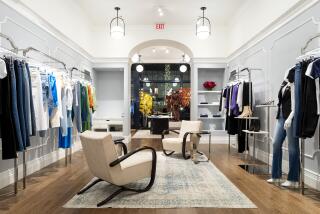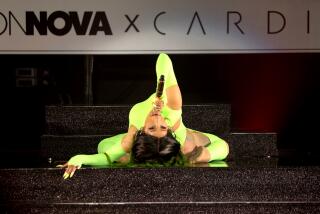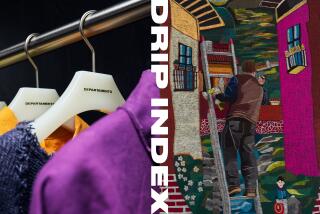Rodeo Drive’s renaissance restores the sheen after the recession
Sitting at the intersection of Hollywood and high fashion, it’s no wonder Rodeo Drive is one of the most fabled shopping streets in the world.
It’s been immortalized in movies, books, song lyrics and on reality TV.
The thoroughfare played a supporting role in the 1990 film “Pretty Woman,” when Julia Roberts went on a Cinderella-like shopping spree. Eddie Murphy flirted with a blond in a Mercedes on the same street in 1984’s “Beverly Hills Cop.”
FOR THE RECORD:
Rodeo Drive: A Sept. 8 timeline that traced the history of Rodeo Drive cited Burton E. Grant as one of the investors who in 1906 bought the land that became Beverly Hills. His name was Burton E. Green.
Late last month, Rodeo Drive was shut down for the elegant global pop-up dinner party “Diner en Blanc,” where 1,200 partygoers, fashionably dressed in white, mingled among the store fronts, further cementing the street’s reputation as L.A.’s luxury living room.
“Beverly Hills has gone from an exclusive enclave to a world icon,” says J.F. Lawton, who wrote the screenplay for “Pretty Woman.” “The film business has become more international, and that has contributed to the glamorous image of Rodeo Drive as a place where the rich and famous shop.”
“The stories of Steve McQueen and Grace Kelly going to Giorgio Beverly Hills in the ‘60s and ‘70s or Katharine Hepburn and Humphrey Bogart having dinner at Romanoff’s in the ‘50s — Rodeo Drive is the epitome of glamour,” says designer Tory Burch, who is slated to open a $7-million Rodeo Drive flagship in November.
“It’s seen as the ultimate in celebrity lifestyle,” says Philip Ferentinos, director of Starline Tours, which offers tours of the area in nine languages. “Internationally, people are interested in movie stars, but Americans and Australians are just as interested in reality TV stars.”
And today the street is in the midst of a renaissance that could very well ensure its supporting role in pop culture for years to come.
For the first time since the recession, there are almost no vacancies among the roughly 100 storefronts along the three-block retail row. On a recent afternoon, the crowds were thick, albeit with cameras outnumbering shopping bags and flip-flops outnumbering stilettos. Cadillac Escalades with blacked-out windows jockeyed for parking spots, as open-air Starline Tours vans with the tops cut off hugged the curbs. “Look, it’s Jennifer Aniston!” a tour operator joked, pointing to an unsuspecting woman in front of the Michael Kors boutique who was most definitely not Jennifer Aniston.
The opening of a new Hermes flagship after an eight-month, $20-million renovation is just the latest in a flurry of development (see related story). From British shoe designer Charlotte Olympia’s first L.A. store, which opened in June at the top of Rodeo, to the new $5-million Celine boutique due south that’s selling $3,000 trapeze bags as fast as if they were $3 lattes, the luxury business appears to be booming.
“We went through this period after the financial crisis when everything stopped. There was this shock, people were afraid to be seen with shopping bags, and a lot of the luxury brands put the brakes on development,” says Chuck Dembo, a real estate broker at Dembo Realty who handles a lot of luxury retail properties in the L.A. area. “Now they have started to invest in new infrastructure, because luxury stores always have to update their look and keep it fresh. Their image is everything.”
It’s hard to say who was first. In October, Dior reopened its 5,000-square-foot store with a design concept borrowed from the brand’s worldwide flagship in Paris on Avenue Montaigne. The atmosphere has a residential feel, with 18th century-inspired furnishings and fixtures mixed with contemporary art commissioned by the house, bringing a new level of luxury experience to the area. In November, Van Cleef & Arpels reopened its historic boutique by treating guests to a garden party and world premiere dance choreography by Benjamin Millepied. And this spring, Prada ditched its Rem Koolhaas-designed retail-as-cultural-epicenter concept in favor of a new, more inviting store.
Recent newcomers to the street include Patek Philippe, Pomellato, Stefano Ricci, Moncler, Vacheron Constantin, Barbara Bui and Frey Wille. Coming soon will be Vera Wang and Burberry. Meanwhile, Louis Vuitton and Saint Laurent are both embarking on multimillion-dollar renovations of their stores.
“With the Internet and social media and how important celebrity is to brands, being here is a must,” says Jay Luchs, executive vice president of real estate agency Newmark Grubb Knight Frank, who has handled many properties on Rodeo Drive. “Celebrities are luxury customers, too. And brands want them to have easy access. Because the minute someone famous wears something here, it goes around the world. Stylists can walk into the stores on Rodeo Drive and pull 10 handbags to take to their clients. Or retailers can impress celebs by having them come into the VIP rooms and penthouses in their stores. They all have spaces in the back alleys where cars can pull up and park. By being on Rodeo Drive, they’re getting celebrities, locals and tourists.”
Another indicator of the value of a Rodeo Drive address is that luxury brands are starting to buy their stores instead of just leasing them. In May, Chanel bought 408 N. Rodeo in one of the highest per-square-foot sales in Los Angeles County, reportedly paying $117 million for the 13,317-square-foot property. LVMH Moet Hennessy Louis Vuitton bought 319 Rodeo for $85 million, and Hermes bought its building for a reported $75 million.
“Those deals happened because those brands are looking at Rodeo as a long-term investment, beyond a 10-year lease with a five-year option to renew,” says Luchs, who worked on the Chanel and LVMH deals. He also noted that competition for open leases has been heating up. When he leased 319 N. Rodeo to Celine earlier this year, it was the first time in five years that he’d had multiple offers on a single property.
And while it may appear on a Saturday afternoon that there are more looky-loos on the street than high-end shoppers, the stores on Rodeo Drive are not just billboards for brands, Luchs says.”They want to do well, and if they don’t, they will leave.”
Pam Danziger, a luxury market researcher and founder of Unity Marketing, agrees.
“Where they used to sell mostly through Saks, Neiman Marcus and other department stores, many luxury brands are now establishing more of their own solo branded stores,” she says. “There’s more profitabilty, and they’ve discovered they are the best equipped to sell their stuff.”
Rodeo Drive is also being bolstered by (and helping to bolster) development on surrounding streets. Beverly Drive has become a hot spot for contemporary brands. All Saints, Theory, Alice & Olivia, Intermix and Scoop all recently opened there, and Maje, Sandro and IRO are coming soon. With the Wallis Annenberg Center for Performing Arts set to open in Beverly Hills in October, there are plenty of attractions to lure shoppers into making a day of it in Beverly Hills. (Between 300,000 and 500,000 people visit Beverly Hills each day, according to the city’s Conference and Visitors Bureau.)
“It’s back to basics,” Luchs says. “Beverly Hills lost its cool factor in 2006-2007, when Marc Jacobs, Marni and Diane von Furstenberg moved to Melrose. And that created buzz.” Chanel, Ralph Lauren and other luxury brands also opened stores on Robertson Boulevard, which are still there.
But the sales figures in stores on those shopping streets didn’t support the inflated rents, says Luchs.
“Brands came to the realization that instead of trying to be different, and going to a location where you don’t even put your name on the door because it’s cool, they should go to a location where everyone is going to find them. Beverly Hills is back because it’s a place you’re going to get eyeballs.”
More to Read
Inside the business of entertainment
The Wide Shot brings you news, analysis and insights on everything from streaming wars to production — and what it all means for the future.
You may occasionally receive promotional content from the Los Angeles Times.











